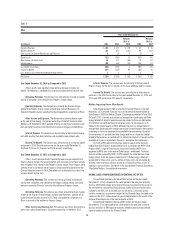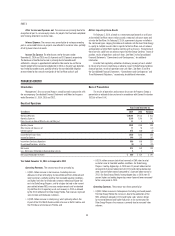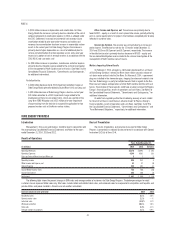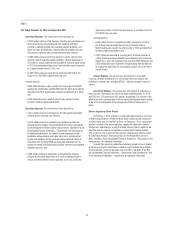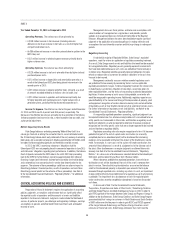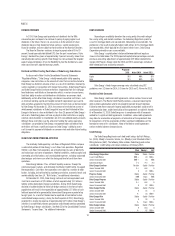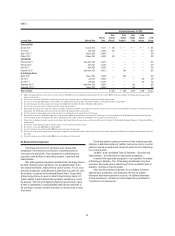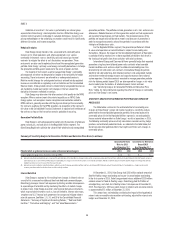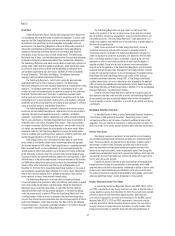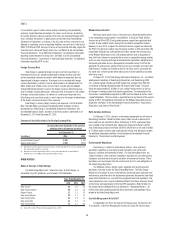Duke Energy 2014 Annual Report Download - page 68
Download and view the complete annual report
Please find page 68 of the 2014 Duke Energy annual report below. You can navigate through the pages in the report by either clicking on the pages listed below, or by using the keyword search tool below to find specific information within the annual report.
48
PART II
are estimated by applying an average revenue per kilowatt-hour (kWh) or per
thousand cubic feet (Mcf) for all customer classes to the number of estimated
kWh or Mcf delivered but not billed. Unbilled wholesale energy revenues are
calculated by applying the contractual rate per megawatt-hour (MWh) to the
number of estimated MWh delivered but not yet billed. Unbilled wholesale
demand revenues are calculated by applying the contractual rate per megawatt
(MW) to the MW volume delivered but not yet billed. The amount of unbilled
revenues can vary signifi cantly from period to period as a result of numerous
factors, including seasonality, weather, customer usage patterns, customer mix
and the average price in effect for customer classes.
Pension and Other Post-Retirement Benefi ts
The calculation of pension expense, other post-retirement benefi t expense
and net pension and other post-retirement assets or liabilities require the use
of assumptions and election of permissible accounting alternatives. Changes
in assumptions can result in different expense and reported asset or liability
amounts, and future actual experience can differ from the assumptions. Duke
Energy believes the most critical assumptions for pension and other post-
retirement benefi ts are the expected long-term rate of return on plan assets
and the assumed discount rate. Additionally, the health care cost trend rate
assumption is critical to Duke Energy’s estimate of other post-retirement
benefi ts.
Duke Energy has historically utilized the Society of Actuaries’ (SOA)
published mortality data in developing a best estimate of mortality as part of
the calculation of the pension obligation (qualifi ed and non-qualifi ed) and other
post-retirement benefi t obligation. On October 27, 2014, the SOA published
updated mortality tables for U.S. plans (RP-2014) and an updated improvement
scale, which both refl ect improved longevity. Based on an evaluation of the
mortality experience of Duke Energy’s pension plan participants, the updated
SOA study of mortality tables and recent additional studies of mortality
improvement, Duke Energy adopted an adjusted version of the SOA’s new RP-
2014 mortality tables with an updated generational improvement scale (BB-2D)
previously published by the SOA for purposes of measuring its U.S. pension
(qualifi ed and non-qualifi ed) and other post-retirement benefi t obligations as
of December 31, 2014. The change to the mortality assumption increased Duke
Energy’s pension obligation (qualifi ed and non-qualifi ed) and other post-
retirement benefi t obligation by $201 million and $7 million, respectively, as of
December 31, 2014.
Duke Energy elects to amortize net actuarial gains or losses in excess
of the corridor of 10 percent of the greater of the market-related value of plan
assets or plan projected benefi t obligation, into net pension or other post-
retirement benefi t expense over the average remaining service period of active
covered employees. Prior service cost or credit, which represents the effect on
plan liabilities due to plan amendments, is amortized over the average remaining
service period of active covered employees.
Duke Energy maintains non-contributory defi ned benefi t retirement
plans. The plans cover most U.S. employees using a cash balance formula.
Under a cash balance formula, a plan participant accumulates a retirement
benefi t consisting of pay credits based upon a percentage of current eligible
earnings based on age and years of service and current interest credits. Certain
employees are covered under plans that use a fi nal average earnings formula.
Duke Energy provides some health care and life insurance benefi ts
for retired employees on a contributory and non-contributory basis. Certain
employees are eligible for these benefi ts if they have met age and service
requirements at retirement, as defi ned in the plans.
As of December 31, 2014, Duke Energy assumes pension and other post-
retirement plan assets will generate a long-term rate of return of 6.50 percent.
The expected long-term rate of return was developed using a weighted average
calculation of expected returns based primarily on future expected returns across
asset classes considering the use of active asset managers, where applicable.
Equity securities are held for their higher expected returns. Debt securities are
primarily held to hedge the pension liability. Hedge funds, real estate and other
global securities are held for diversifi cation. Investments within asset classes
are to be diversifi ed to achieve broad market participation and reduce the
impact of individual managers on investments. In 2013, Duke Energy adopted
a de-risking investment strategy for its pension assets. As the funded status of
the plans increase, over time the targeted allocation to return seeking assets will
be reduced and the targeted allocation to fi xed-income assets will be increased
to better manage Duke Energy’s pension liability and reduced funded status
volatility. Based on the current funded status of the plans, the asset allocation
for the Duke Energy pension plans has been adjusted to 65 percent fi xed-income
assets and 35 percent return-seeking assets and the asset allocation for the
Progress Energy pension plans has been adjusted to 60 percent fi xed-income
assets and 40 percent return-seeking assets. Duke Energy regularly reviews
its actual asset allocation and periodically rebalances its investments to the
targeted allocations when considered appropriate.
The assets for Duke Energy’s pension and other post-retirement plans are
maintained in a master trust. Duke Energy also invests other post-retirement
assets in the Duke Energy Corporation Employee Benefi ts Trust (VEBA I). The
investment objective of VEBA I is to achieve suffi cient returns, subject to a
prudent level of portfolio risk, for the purpose of promoting the security of plan
benefi ts for participants. VEBA I is passively managed.
Duke Energy discounted its future U.S. pension and other post-retirement
obligations using a rate of 4.1 percent as of December 31, 2014. Discount
rates used to measure benefi t plan obligations for fi nancial reporting purposes
refl ect rates at which pension benefi ts could be effectively settled. As of
December 31, 2014, Duke Energy determined its discount rate for U.S. pension
and other post-retirement obligations using a bond selection-settlement portfolio
approach. This approach develops a discount rate by selecting a portfolio of high
quality corporate bonds that generate suffi cient cash fl ow to match the timing
of projected benefi t payments. The selected bond portfolio is derived from a
universe of non-callable corporate bonds rated Aa quality or higher. After the
bond portfolio is selected, a single interest rate is determined that equates the
present value of the plan’s projected benefi t payments discounted at this rate
with the market value of the bonds selected.
Future changes in plan asset returns, assumed discount rates and
various other factors related to the participants in Duke Energy’s pension and
post-retirement plans will impact future pension expense and liabilities. Duke
Energy cannot predict with certainty what these factors will be in the future. The
following table presents the approximate effect on Duke Energy’s 2014 pretax
pension expense, pretax other post-retirement expense, pension obligation and
other post-retirement benefi t obligation if a 0.25 percent change in rates were
to occur.
Qualifi ed and Non-
Qualifi ed Pension Plans Other Post-Retirement Plans
(in millions) +0.25% -0.25% +0.25% -0.25%
Effect on 2014 pretax pension and other post-retirement expense
Expected long-term rate of return $ (19) $ 19 $ (1) $ 1
Discount rate (17) 16 (2) 2
Effect on pension and other post-retirement benefi t obligation at December 31, 2014
Discount rate $ (198) $ 203 $ (20) $ 21


